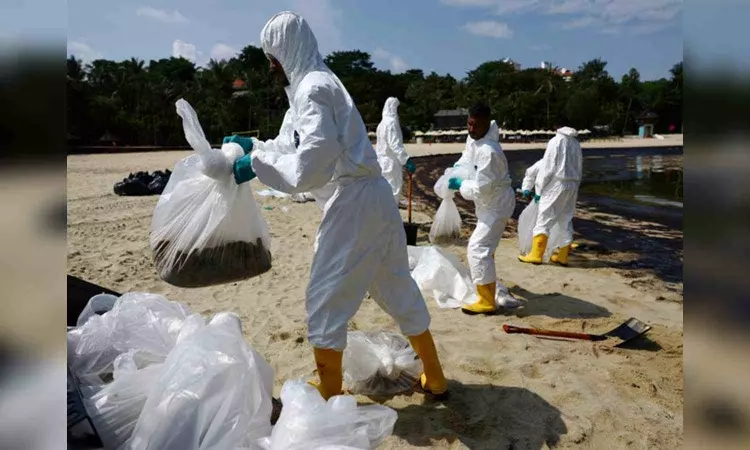Singapore: Beaches on three islands shut after oil spill spread to several coastlines
Staff from NParks, together with volunteers from Friends of Marine Park, visited St John's and Lazarus islands on Sunday to observe and document the effect of the oil spill in these areas.

Workers clean up an an oil slick at Tanjong Beach in Singapore's Sentosa (Reuters)
SINGAPORE: The authorities on Sunday announced that the beaches on three Singapore islands will be shut until further notice after an oil spill on Friday spread to several coastlines, Channel News Asia (CNA) reported.
The beaches at St John's, Lazarus and Kusu islands will be closed after oil slicks were seen at the first two islands.
Staff from NParks, together with volunteers from Friends of Marine Park, visited St John's and Lazarus islands on Sunday to observe and document the effect of the oil spill in these areas.
The closure of the beaches at the islands is in addition to areas B to H of East Coast Park, as well as the jetty and rocky shore of Labrador Nature Reserve, which have been shut since Saturday, according to CNA report.
Sentosa's beaches remain open for people. However, sea activities and swimming are still not permitted at Tanjong, Palawan and Siloso beaches.
As of 1:30 pm on Sunday, there were no signs of oil slick within Sisters' Islands Marine Park. However, the oil sheen was witnessed in the surrounding waters.
The latest update was a joint statement released by the Maritime and Port Authority (MPA), the National Environment Agency (NEA), the National Parks Board (NParks) and Sentosa Development Corporation (SDC) on Sunday evening.
Oil washed up on some of the beaches of Singapore after dredger Vox Maxima hit stationary bunker vessel Marine Honour at Pasir Panjang Terminal on Friday at about 2:20 pm (local time). This causes some oil from a cargo tank on the bunker vessel to spill into the water.
Maritime and Port Authority (MPA) is working with British Marine, the insurer of the stationary tanker, to set up a contact for third-party claims by "affected parties who have been impacted".
In the joint statement, the authorities said the dredger had reported a sudden loss in engine and steering control before it hit the bunker vessel on Friday. This resulted in the rupture of the vessel's oil cargo tanks and its contents of low-sulphur fuel oil were released into the sea.
MPA patrol craft were being used to spray dispersants on the spill. The authority's response contractor was activated and they mobilised an oil skimmer to reduce the impact of the spill.
The craft skims and lifts the oil off the water surface into storage tanks. The authorities said, "Booms were also laid around the vessels thereafter as added precaution in case of further leaks from the vessel."
It further said, "Due to the tidal currents, parts of the oil spillage have landed along the southern shorelines including Sentosa, Labrador Nature Reserve, Southern Islands, Marina South Pier, and East Coast Park."
MPA has been carrying out the investigation and the master of the vessel and its crew are assisting in the probe. Oil recovery efforts are being conducted at sea. Oil Spill Response Limited (OSRL), the largest international industry-funded cooperative providing oil spill response services, is helping in the clean-up efforts.
It will deploy two floating containment and recovery devices and consists of a boom with a skirt that extends below the water surface to corral and concentrate the oil on the water surface, CNA
As of 1.30 pm on Sunday, no oil slick has been reported in the Traffic Separation Scheme of the Singapore Strait, and navigation remains unimpacted. Port operations continue to remain normal.
People have been advised to keep away from the impacted beaches as clean-up operations are being conducted. Close to 1,500m of containment booms have been deployed since Friday at various places, including the three beaches at Sentosa, the entrance of Keppel Marina, off Labrador Nature Reserve, East Coast Park and West Coast Park, according to CNA report.
Another 1,600m of booms will be deployed the next few days to stop further spread of oil onto the shore. The authorities said, "The booms are less effective when there are higher waves above 0.5m. Use of dispersants can help to break down the surface oil into droplets to enhance biodegradation." It added, "For treated oil with dispersants, these may be suspended in the water and be carried by tidal currents to coastlines."
Over 250 personnel have been deployed, including over 50 workers from OSRL, 50 NParks officers, cleaners and other officers to support clean-up efforts at the beach and shoreline. There have been over 1,500 sign-ups by people looking to help. NParks said it will activate volunteers if additional assistance was required, CNA reported.
The authorities said, "For their safety, volunteers will not be deployed for shoreline clean-up." Some volunteers have been activated to keep a watch on the situation at West Coast Park and to alert the authorities should there be signs of the oil spill.
Authorities have not seen any effect of the oil spill at the park. Volunteers will also patrol the beach areas at East Coast Park on Monday. These volunteers at both parks can help with information sharing and reporting on impacted wildlife and areas.



